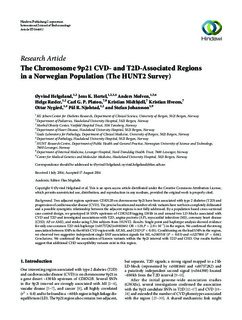| dc.contributor.author | Helgeland, Øyvind | |
| dc.contributor.author | Hertel, Jens Kristoffer | |
| dc.contributor.author | Molven, Anders | |
| dc.contributor.author | Ræder, Helge | |
| dc.contributor.author | Platou, Carl Geoffrey Parrinder | |
| dc.contributor.author | Midthjell, Kristian | |
| dc.contributor.author | Hveem, Kristian | |
| dc.contributor.author | Nygård, Ottar | |
| dc.contributor.author | Njølstad, Pål Rasmus | |
| dc.contributor.author | Johansson, Stefan | |
| dc.date.accessioned | 2015-04-08T12:02:01Z | |
| dc.date.accessioned | 2015-10-20T14:09:18Z | |
| dc.date.available | 2015-04-08T12:02:01Z | |
| dc.date.available | 2015-10-20T14:09:18Z | |
| dc.date.issued | 2015 | |
| dc.identifier.citation | International Journal of Endocrinology 2015 | nb_NO |
| dc.identifier.issn | 1687-8345 | |
| dc.identifier.uri | http://hdl.handle.net/11250/2357317 | |
| dc.description.abstract | Background. Two adjacent regions upstream CDKN2B on chromosome 9p21 have been associated with type 2 diabetes (T2D) and
progression of cardiovascular disease (CVD).The precise location and number of risk variants have not been completely delineated
and a possible synergistic relationship between the adjacent regions is not fully addressed. By a population based cross-sectional
case-control design, we genotyped 18 SNPs upstream of CDKN2B tagging 138 kb in and around two LD-blocks associated with
CVD and T2D and investigated associations with T2D, angina pectoris (AP), myocardial infarction (MI), coronary heart disease
(CHD; AP or AMI), and stroke using 5,564 subjects from HUNT2. Results. Single point and haplotype analysis showed evidence
for only one common T2D risk haplotype (rs10757282|rs10811661: OR = 1.19, 𝑃? = 2.0 × 10−3) in the region.We confirmed the strong
association between SNPs in the 60 kb CVD region with AP, MI, and CHD(𝑃? < 0.01). Conditioning on the lead SNPs in the region,
we observed two suggestive independent single SNP association signals for MI, rs2065501 (𝑃? = 0.03) and rs3217986 (𝑃? = 0.04).
Conclusions. We confirmed the association of known variants within the 9p21 interval with T2D and CHD. Our results further
suggest that additional CHD susceptibility variants exist in this region. | nb_NO |
| dc.language.iso | eng | nb_NO |
| dc.publisher | Hindawi Publishing Corporation | nb_NO |
| dc.title | The Chromosome 9p21 CVD- and T2D-Associated Regions in a Norwegian Population (The HUNT2 Survey) | nb_NO |
| dc.type | Journal article | nb_NO |
| dc.type | Peer reviewed | en_GB |
| dc.date.updated | 2015-04-08T12:02:01Z | |
| dc.subject.nsi | VDP::Medisinske fag: 700::Klinisk medisinske fag: 750::Endokrinologi: 774 | nb_NO |
| dc.subject.nsi | VDP::Midical sciences: 700::Clinical medical sciences: 750::Endocrinology: 774 | nb_NO |
| dc.subject.nsi | VDP::Medisinske fag: 700::Basale medisinske, odontologiske og veterinærmedisinske fag: 710::Medisinsk genetikk: 714 | nb_NO |
| dc.subject.nsi | VDP::Midical sciences: 700::Basic medical, dental and veterinary sciences: 710::Medical genetics: 714 | nb_NO |
| dc.source.journal | International Journal of Endocrinology | nb_NO |
| dc.identifier.doi | 10.1155/2015/164652 | |
| dc.identifier.cristin | 1229721 | |
| dc.description.localcode | Copyright © Øyvind Helgeland et al. This is an open access article distributed under the Creative Commons Attribution License, which permits unrestricted use, distribution, and reproduction in any medium, provided the original work is properly cited. | nb_NO |
